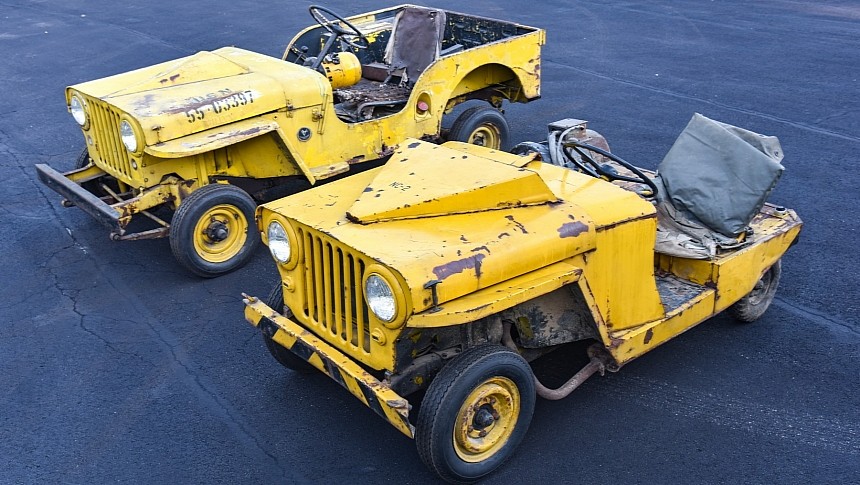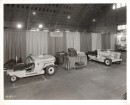Let's paint the scene for you. It's December 1965, and you're aboard the Iwo Jima-class amphibious assault ship USS Guadalcanal somewhere in the Caribbean Sea. You're about to take the stick of a Sikorsky CH-37 Mojave transport helicopter to pick up some more rations and other riff-raff from a supply depot on land, but not before a Willys-Overland CJ-3A APU vehicle tootles on by to help you start your big helicopter's turbine engine. Fifty-eight years later, these two little Jeeps look a little worse for wear.
Even so, it's hard not to be charmed by two bright yellow Willys Overland Jeeps with their timeless front facia juxtaposed with the remarkably non-off-road-looking wheel and tire arrangement. The weirder-looking of these twin Jeeps wasn't built to traverse dirty trails. Instead, the NC-2, as it was known, spent a good portion of its life aboard U.S. Navy warships as a mobile power plant. Built to haul the auxiliary power unit (APU) needed to coax a Mohave's Pratt & Whitney R-2800 Double Wasp engines to life.
To compensate for the cramped and hectic conditions aboard Navy aircraft carriers and amphibious assault ships, the NC-2 was modified to feature a freaky-looking, rear-wheel-steer system to help the pint-sized Jeep navigate the chaos on their decks like a forklift. Because its rear wheels and tires look more like large bagels, the NC-2's drive wheels are now at the front. It beats the Jeep Patriot to the title of the first front-wheel-drive Jeep by a good four or five decades. It's thanks to the long-forgotten Valentine Welder & Mfg Company of Detroit, Michigan, that these two Jeeps look the way they do.
The U.S. Navy first contracted the company to modify Willys-Overland chassis into purpose-built utility vehicles at sea in the 1950s. The firm had the benefit of working with slightly newer CJ-3A Willys-Overland Jeeps, introduced in 1949 to replace the CJ-2A with a model sporting better legroom and better leak protection in its canvas rooftop. It also introduced a more modern, one-piece windscreen that'd stay with the CJ lineup to the end of its life in the mid-1980s. Not that either of the Navy machines here has a windscreen, anyway.
All the while, the second Jeep in the pair is the more conventional land-based NA-4. It sports a far more conventional, rear-drive platform more suited to the air bases it would have spent its days. Generations have passed since either of these machines was retired and left to rust back into the ground they came from. But there are air and space museums across America whose mostly volunteer forces restore combat-veteran warbirds to display-worthy or even full-on airworthy conditions.
If it's possible to piece together the remains of two fighter planes that collided mid-air, it's possible to restore these two Jeeps back to museum-quality running order.
Even so, it's hard not to be charmed by two bright yellow Willys Overland Jeeps with their timeless front facia juxtaposed with the remarkably non-off-road-looking wheel and tire arrangement. The weirder-looking of these twin Jeeps wasn't built to traverse dirty trails. Instead, the NC-2, as it was known, spent a good portion of its life aboard U.S. Navy warships as a mobile power plant. Built to haul the auxiliary power unit (APU) needed to coax a Mohave's Pratt & Whitney R-2800 Double Wasp engines to life.
To compensate for the cramped and hectic conditions aboard Navy aircraft carriers and amphibious assault ships, the NC-2 was modified to feature a freaky-looking, rear-wheel-steer system to help the pint-sized Jeep navigate the chaos on their decks like a forklift. Because its rear wheels and tires look more like large bagels, the NC-2's drive wheels are now at the front. It beats the Jeep Patriot to the title of the first front-wheel-drive Jeep by a good four or five decades. It's thanks to the long-forgotten Valentine Welder & Mfg Company of Detroit, Michigan, that these two Jeeps look the way they do.
The U.S. Navy first contracted the company to modify Willys-Overland chassis into purpose-built utility vehicles at sea in the 1950s. The firm had the benefit of working with slightly newer CJ-3A Willys-Overland Jeeps, introduced in 1949 to replace the CJ-2A with a model sporting better legroom and better leak protection in its canvas rooftop. It also introduced a more modern, one-piece windscreen that'd stay with the CJ lineup to the end of its life in the mid-1980s. Not that either of the Navy machines here has a windscreen, anyway.
All the while, the second Jeep in the pair is the more conventional land-based NA-4. It sports a far more conventional, rear-drive platform more suited to the air bases it would have spent its days. Generations have passed since either of these machines was retired and left to rust back into the ground they came from. But there are air and space museums across America whose mostly volunteer forces restore combat-veteran warbirds to display-worthy or even full-on airworthy conditions.
If it's possible to piece together the remains of two fighter planes that collided mid-air, it's possible to restore these two Jeeps back to museum-quality running order.














































